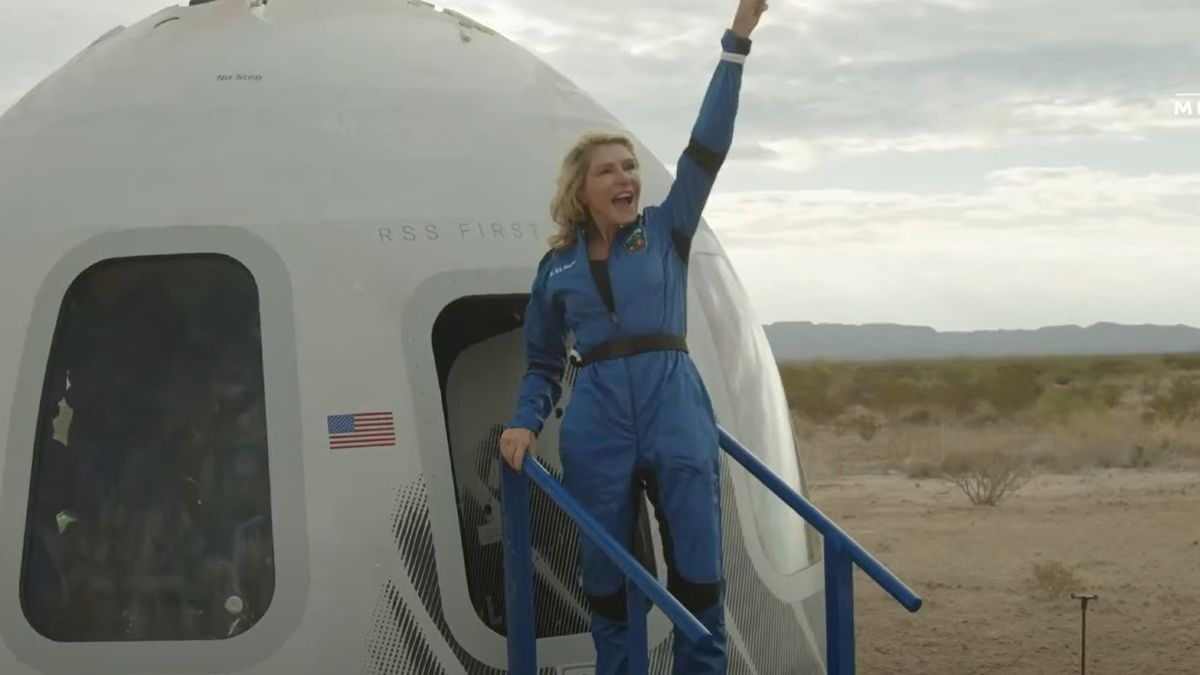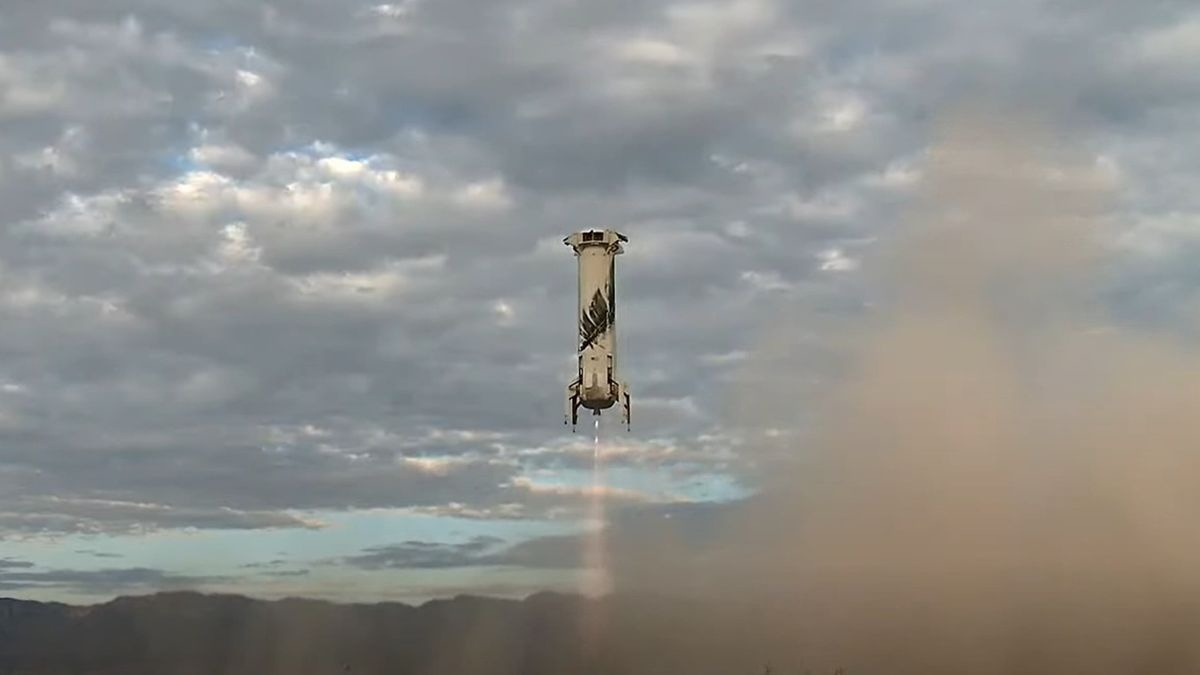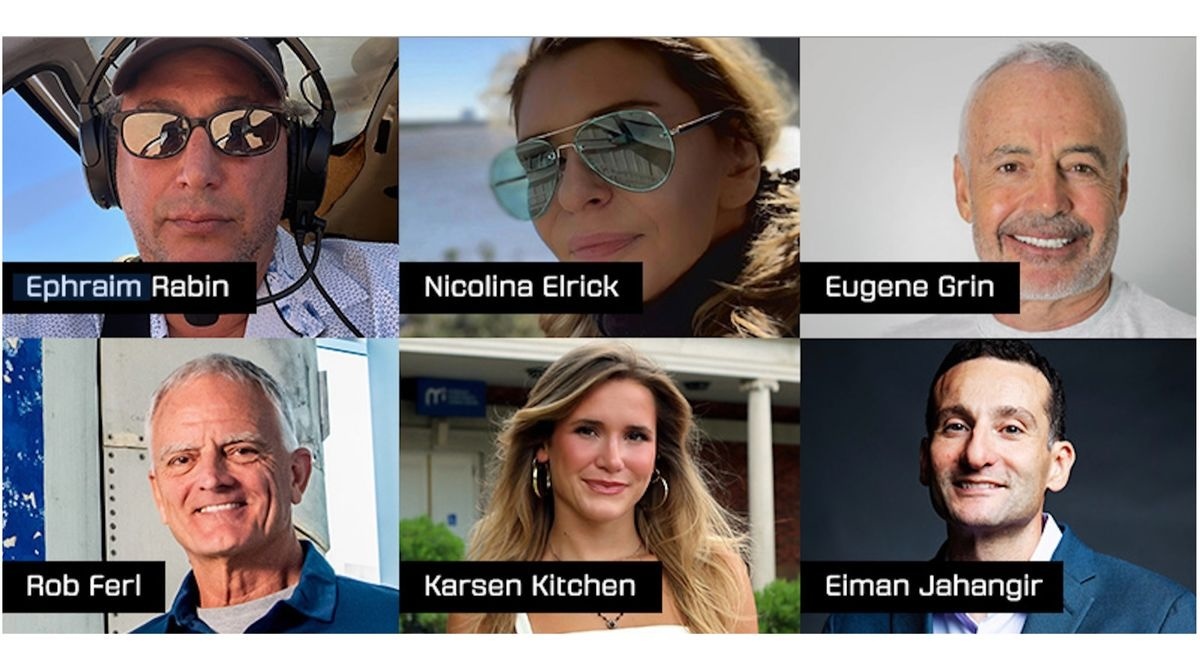25.08.2024
UF SCIENTIST PREPARES TO LAUNCH INTO SPACE THURSDAY, AUG. 29

As a crew member on board the Blue Origin New Shepard rocket, UF/IFAS researcher Rob Ferl will conduct his own study on plants in space
What does the adaptation process look like for plants in space?
That’s the question the University of Florida Institute of Food and Agricultural Sciences (UF/IFAS) hopes to answer with a novel space-based experiment happening Thursday at 9 a.m. EST when a UF/IFAS horticultural sciences researcher launches with his experiment into suborbital space on a Blue Origin New Shepard rocket.
Rob Ferl, Ph.D., the University of Florida Astraeus Space Institute director, will fly in the Blue Origin craft and perform the experiment himself. The experiment builds on prior research that showed a type of plant – Arabidopsis thaliana – can detect that it is in space and then change how its genes are expressed.
"This moment is a milestone not just for the University of Florida and the Astraeus Space Institute but for an entire community of scientists who can now consider experiments in space that might have previously been viewed as impossible," said UF Interim President Kent Fuchs. "I look forward to cheering Rob on during Thursday’s mission and to watching him make history yet again."
This experiment will determine which genes turn on and off at various stages of flight. Although much is known about how plants respond to living in spaceflight environments, like the International Space Station, researchers know less about how plants respond molecularly as they travel to space. The experiment will provide new insights into how plants adjust their gene expression as they transition from Earth to space.
One day, plants might be an essential part of space exploration as food and air scrubbers, and understanding how they react to a space environment is the first step toward learning how to effectively grow them there.
“We envision plants will keep us alive in space or on the moon,” said Ferl, who is also assistant vice president for UF Research. “What does it take to adapt to living in space? We’d like to know.”
Anna-Lisa Paul, Ph.D., co-principal investigator for the experiment, a horticultural sciences research professor and director of UF’s Interdisciplinary Center for Biotechnology Research, said researchers have only been able to see what this plant’s genes are like before and after space flight, not during.
“It’s something outside the evolutionary environment of any terrestrial species,” she said. “This is something we’re learning that has never been done before.”
This groundbreaking research on plants in space is funded by a grant from NASA's Flight Opportunities program and the agency's Biological and Physical Sciences division.
Ferl will carry the plants in specialized tubes, called Kennedy Space Center Fixation Tubes (KFTs), that have a plunger to release a preservative solution. The tubes will be Velcroed to the legs of his flight suit during the flight. Before and after the flight, they will be moved in custom transit bags designed by the UF Space Plants Lab out of blackout fabric and a golden thermal blanket.
The experiment involving plants in space has a second purpose: to validate that having researchers do their own experiments on flights is a valuable use of research funding, rather than relying on untended experiments or robotics. This is the first NASA-supported researcher-tended suborbital flight.
“There’s something to be said about first-hand experience,” Ferl said. “The experiment is enriched when a human mind and a human brain go with it.”
The study will look at the plant’s transcriptome, the collection of all expressed RNA that contains answers to which genes are turned on and off to change the plant to adapt in a space environment. Ferl will chemically “lock” the genes with a preservative solution to pause the plants at a moment in time during various points in the launch – just before takeoff, at the start of zero gravity, at the end of zero gravity and at landing.
Researchers will then sequence the plants’ expressed genes and compare them to an on-Earth control experiment to figure out exactly which ones were activated or deactivated during the flight.
Jordan Callaham, assistant director for the UF Astraeus Space Institute and research coordinator for the UF Space Plants Lab in the UF/IFAS department of horticultural sciences, said this will help researchers begin to understand how plants would respond on space missions, on the moon or on Mars. But it will also give them a better idea of the fundamental properties of the chemical pathways within plants and how they respond to all novel environments.
“We’re understanding how biology responds to space on a very basic level,” said Callaham, who will be doing the on-Earth control experiment while Ferl is on the Blue Origin rocket.
Quelle: University of Florida
+++
Blue Origin Sets Aug. 29 For Next New Shepard Launch
After resolving a problem that impaired operation of one of the three parachutes on the last flight of its New Shepard (NS) suborbital spacecraft, Blue Origin is targeting its next passenger mission for Aug. 29, the company said Aug. 23. The launch window for NS-26—the company’s eighth with...
New Shepard’s Crewed NS-26 Mission Targets Liftoff on August 29
Blue Origin announced today its eighth human flight, NS-26, will lift off from Launch Site One in West Texas on Thursday, August 29. The launch window opens at 8:00 AM CDT / 1300 UTC. The webcast on BlueOrigin.com will start at T-40 minutes.

A few of the symbols embedded in the NS-26 patch include:
- The green color and plants ascending in spiral lines represent the living organisms in Rob Ferl’s onboard experiment.
- The spiral lines indicate the slight rotation of the crew capsule when it separates from the booster. The continuous loop also represents Ephraim Rabin’s career in supply chain.
- The heart represents Dr. Eiman Jahangir’s career as a cardiologist; the spiral line toward space represents his lifelong passion for reaching toward the stars, and Eugene Grin’s passion for travel.
- The children at the bottom represent Karsen Kitchen and Nicolina Elrick’s childhood dreams to go to space. They also represent Club for the Future’s mission to inspire and mobilize future generations to pursue STEAM careers.
Blue Origin Announces Crew for New Shepard’s 26th Mission
July 24, 2024
Blue Origin today revealed the six-person crew flying on its NS-26 mission. The crew includes: Nicolina Elrick, Rob Ferl, Eugene Grin, Dr. Eiman Jahangir, Karsen Kitchen, and Ephraim Rabin. Karsen will become the youngest woman ever to cross the Kármán line.
Ferl will be the first NASA-funded researcher to conduct an experiment as part of a commercial suborbital space crew. The experiment is designed to help scientists understand how plant genes react to the transition to and from microgravity. Ferl will activate a device called a Kennedy Space Center Fixation Tube, or KFT, to “fix” or take a snapshot of the gene activity of an Arabidopsis thaliana plant inside the tube so researchers can later study it in the lab. On the ground, co-investigator Anna-Lisa Paul will track Ferl’s actions and activate identical control KFTs at the same four times during the flight.

This mission will be the eighth human flight for the New Shepard program and the 26th in its history. To date, the program has flown 37 humans above the Kármán line, the internationally recognized boundary of space.
Meet the Crew
Nicolina Elrick
Nicolina is a philanthropist and entrepreneur whose career spans high fashion modeling to property development and founding multiple IT corporations in the 1990s. A graduate of CoachU and a vocal advocate for STEM education, she has dedicated her life to mentoring aspiring entrepreneurs. Her forthcoming biography, "Grit, Diamonds, Stars," delves into her journey, offering insights into overcoming hardship with grace and determination. Based in Singapore, Nicolina is a certified helicopter pilot and a spirited explorer with a love for cars, fine wine, and the occasional cigar.
Rob Ferl
Rob is a distinguished professor and director of the Astraeus Space Institute at the University of Florida. He has spent his career studying how living organisms respond to extreme conditions, especially microgravity. He and his colleagues have worked with NASA astronauts to conduct numerous experiments on the International Space Station that have shown that plants turn certain genes on and off in response to changes in gravity. They were also the first to prove that plants could grow in lunar soil collected during the Apollo missions. Ferl is also a national leader in space policy, having recently chaired a National Academies of Sciences committee on the direction of space biology research over the next decade.
Rob received funding for this technology flight test through a NASA TechFlights grant by the agency’s Flight Opportunities program as well as from NASA’s Division of Biological and Physical Sciences.
Eugene Grin
Eugene was born in Ukraine and emigrated to the United States in 1979, where he started his career in real estate and finance. His passions include meditation, travel, and adventure sports. He lives in upstate New York and has four children.
Dr. Eiman Jahangir
Eiman is a cardiologist and Associate Professor of Medicine and Radiology at Vanderbilt University Medical Center, where he treats patients with heart disease and educates future physicians. Outside of medicine, he has a passion for exploration, including a lifelong dream of going to space. Over the past two decades, Eiman has participated in analog astronaut missions and trained in various aspects of human spaceflight. This mission not only fulfills his dream but also represents his vision of making space accessible to everyone.
Eiman's seat is sponsored by MoonDAO, an organization whose mission is to accelerate a multiplanetary future.
Karsen Kitchen
Karsen is poised to make history as the youngest woman ever to cross the Kármán line. A senior at the University of North Carolina at Chapel Hill, Karsen is majoring in Communications and Astronomy. After graduation, she intends to pursue a career in the space industry. In 2024, she founded Orbitelle, an initiative to encourage women to pursue careers in the space industry. Karsen has researched radio astronomy at the Green Bank Observatory in West Virginia and worked at UNC's Morehead Planetarium. She’s also immersed herself in centrifugal force training, experienced weightlessness during a Zero-Gravity flight, and currently in training for her scuba diving license.
Ephraim Rabin
Ephraim is an American-Israeli businessman, philanthropist, and entrepreneur. He is the founder and CEO of Parchem Fine & Specialty Chemicals, a technology company revolutionizing supply chains for specialized raw materials and ingredients globally. Ephraim is a trustee and mentor at a variety of organizations and think tanks, as well as a race car driver, chef, and avid skier and adventurer. Ephraim and his family split their time between New York, Israel, and the Caribbean.
The flight date will be announced soon.
Quelle: Blue Origin
----
Update: 30.08.2024
.
'One of the cleanest flights I've seen.' Blue Origin launches 6 people to space, lands safely on NS-26 flight
Liftoff occurred at 9:07 a.m. EDT (1307 GMT).
Blue Origin launched and landed its eighth suborbital space tourism mission this morning.
Blue Origin, which is run by Amazon founder Jeff Bezos, sent the six-person NS-26 flight to space from its West Texas spaceport today. Liftoff occurred at 9:07 a.m. EDT (1307 GMT; 8:07 a.m. local Texas time). The flight reached a maximum altitude of around 341,000 feet (104,000 meters) before coming back for a touchdown in the West Texas dust around 9:19 a.m. EDT (1319 GMT or 8:19 a.m. local time).
As the crew stepped out of the RSS First Step capsule, they cheered to the friends and family gathered to watch their return. "I went to space!" screamed passenger Nicolina Elrick as she pumped her hands in the air as the first crewmember out.

Blue Origin NS-26 passenger Nicolina Elrick celebrates after landing on Aug. 29, 2024. (Image credit: Blue Origin via YouTube)
The mission appeared to have gone flawlessly. "Up and back. That is just one of the cleanest flights I've seen from this rocket. But behind every rocket is an extraordinary team," said Blue Origin launch commentator Ariane Cornell upon the capsule's return.

Blue Origin's New Shepard booster returns for landing after launching the NS-26 mission on Aug. 29, 2024. (Image credit: Blue Origin via YouTube)
As the mission's name suggests, NS-26 was the 26th flight overall for New Shepard. The mission launched atop the company's New Shepard rocket, Blue Origin's reusable rocket-capsule combo. It was the eighth such mission to carry people.
New Shepard flights last 10 to 12 minutes from liftoff to capsule touchdown. Passengers aboard the vehicle get to experience a few minutes of weightlessness and travel above the Kármán line, the 62-mile-high (100-kilometer-high) marker that many people regard as the boundary of outer space.
Blue Origin has not revealed how much a seat aboard New Shepard costs. Virgin Galactic, the company's main competitor in the suborbital space tourism field, currently charges $600,000 per ticket.

The crew of Blue Origin's upcoming NS-26 suborbital mission. (Image credit: Blue Origin
The six people that flew on NS-26 included philanthropist and entrepreneur Nicolina Elrick, university professor Rob Ferl, businessman Eugene Grin, cardiologist Eiman Jahangir, college student Karsen Kitchen and entrepreneur Ephraim Rabin.
Ferl became the first NASA-funded researcher to fly to space with the flight, during which the University of Florida scientist and director of the university's space institute conducted experiments on plant growth in microgravity. "As commercial space programs have advanced and access to space has become more available, I always hoped I might be able to conduct our experiments myself in microgravity," Ferl said in a University of Florida statement.
"I feel very grateful for this opportunity. After years, decades even, of working with astronauts to conduct our experiments, it's an honor to be at the forefront of researchers conducting their own experiments in space," Ferl said.
The 21-year-old Kitchen set a record on the flight, becoming the youngest woman ever to cross the Kármán line, according to Blue Origin. But not everyone will regard her as the youngest woman to reach space; NASA and the U.S. military award astronaut wings to anyone who gets above 50 miles (80 km), a mark that 18-year-old Anastatia Mayers hit on a Virgin Galactic flight in August 2023.
NS-26 was the third launch for New Shepard since the vehicle failed on a robotic research flight in September 2022, resulting in the loss of the first-stage rocket. (The capsule landed safely.) New Shepard returned to flight with an uncrewed launch in December 2023, then flew people this past May on NS-25.
Quelle: SC
